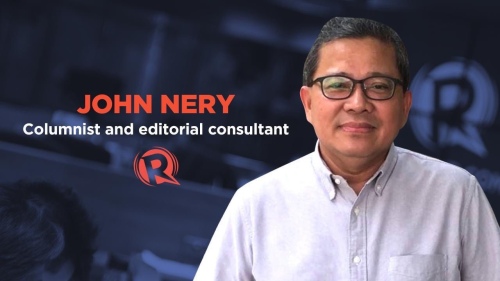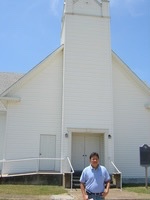
After 20 years with the Philippine Daily Inquirer, I joined Rappler in October 2021.
At Rappler, I write a weekly column (Newsstand, out on Tuesdays) and serve as an editorial consultant. During the 2022 election cycle, I hosted the election show “On the Campaign Trail.” Since June 1, 2022, I anchor the Rappler public affairs program “In the Public Square.”
I also teach media and politics at the Ateneo de Manila as a lecturer in the Department of Communication, serve on the board of the Asian Center for Journalism, and co-convene the Consortium on Democracy and Disinformation. As one way to integrate all these responsibilities together, I started a newsletter called Political Animal.
https://www.getrevue.co/profile/jnery_newsstand
Email: newsstand@protonmail.com or john.nery@rappler.com
At the Inquirer, I wore a number of hats: editorial writer (2001-2018), investigative team editor (2001-2002), central desk editor (2001-2003), accidental TV producer (2003-2006), columnist (2007-2021), editor in chief of Inquirer.net (2014-2017), debate organizer (2010, 2013, 2016), INQ&A radio host (2016-2017). I retired in November 2018, and wrote my last column in October 2021.
I was a Jefferson Fellow at the East West Center in Honolulu in the spring of 2005; a Visiting Research Fellow at the Institute of Southeast Asian Studies in Singapore from 2009 to 2011; and a Nieman Fellow in Journalism (the first Sandra Burton grantee) in Harvard University, class of 2012.
I wrote Revolutionary Spirit: Jose Rizal in Southeast Asia in 2011 (original Singapore edition published by ISEAS, Philippine edition by the Ateneo de Manila University Press), to mark the 150th birth anniversary of the patriot, polymath, and pioneer anti-colonial novelist.
But allow me to belabor the obvious: Newsstand (on Typepad from 2005 to 2009, and since then on WordPress) is a personal blog, and I do not speak for any of the institutions I am associated with, or necessarily reflect their point of view. My opinions, such as they are, are my own.

THE PHOTO ABOVE was taken in May 2005 at the Baptist church just outside Crawford, Texas, which George W. Bush is said to attend when he is in town. It evokes, or so it appears to me, the kind of stories I am interested in: the intersection of politics and personality, the place of morality in the public square, the byways and backwaters of history.
If education is explanation, please read on.
THE JESUITS’ FAULT
From the December 11, 2006 issue of the Philippine Daily Inquirer
It was the turn of the Class of 1981—that is, my high school class—to host the university’s annual alumni homecoming last Saturday; I could not make it, because of the press of work. Since some of the work involved was not required but volunteered, and much of it involved the practical arts of rhetoric, I suppose I can lay part of the blame at the feet of the Jesuits.
Throughout my formative years at the Ateneo de Manila, an entire generation ago, the dominant educational philosophy revolved around the Ignatian principles of sapientia et eloquentia—core values Fr. Ben Nebres has recently updated to mean “solid learning and effective communication,” but which we understood, in our growing-up years, in somewhat more mystical terms, as wisdom and eloquence.
Let me be more precise: When I was in high school, the university was in the middle of a great transition, a change in its way of proceeding that mirrored not only the social ferment in the Philippines but also the radical reorientation of the worldwide Jesuit apostolate in education. (“Way of proceeding” is characteristic Ignatian language; like his 19th-century son Gerard Manley Hopkins, the 16th-century founder St. Ignatius had a gift for the specific and evocative phrase.)
We were in senior year when we first read the famous Decree 4 of the 32nd General Congregation, which redefined the mission of the Society of Jesus as “the service of faith, of which the promotion of justice is an absolute requirement.” (We had no choice; it was required reading.) By that time, Decree 4 was five years old, and the speech of modern-day saint Pedro Arrupe that had inspired it (and coined the phrase “man for others”) was a sturdy seven years old. Even those of us in high school who were consumed by the academic race or distracted by new discoveries (such as the “softness of women,” in a classmate’s specific, evocative words) could sense that the Ateneo of old was changing. It was now sapientia et eloquentia, but in the service of the faith.
It still is. The school may have grown to include other colleges and to embrace other disciplines in the last 25 years, but at heart it remains a liberal-arts institution; that is to say, the arts and sciences that empower us to become free and to practice the many uses of freedom, summarized in that Latin benediction of sapientia et eloquentia, continue to form the core of Ateneo education.
Not many Ateneo graduates end up as journalists but, in my own case, my path to media work can be traced back willy-nilly (more willy than nilly, to appropriate a quote from an English judge) to the years I spent at the Ateneo—and directly to the Ateneo’s core curriculum. (In other words, it really is the Jesuits’ fault.)
The culture of schools
As a journalist, I am often given the chance to explain the news and the news-making process at various forums, many of which are hosted by educational institutions. This year, perhaps because I was already in a homecoming frame of mind, I took careful note of the schools I found myself speaking in.
I wanted to find out: What makes one school different from another? Or, conversely, what do the best schools have in common with each other? Over time, I realized that the most successful schools were marked by a culture of success; the most distinctive, a culture of distinction; the most socially engaged, a culture of social engagement. In other words, I found that what defines a school’s place in its community and in society at large is its dominant culture.
The culture of the Ateneo de Manila a generation ago was unmistakable. It was thoroughly Jesuit, as I thought then and as I can confirm now. The question is: What made it so? It certainly couldn’t have been the number of Jesuits serving in the high school, because my class lived in the immediate post-Vatican II age, when thousands left the priesthood and the trenches of basic education were suddenly emptied.
It must have been the culture.
Culture, however, is like a dance: you can’t tell it apart from the dancer. In our case, the Jesuit cast of Ateneo culture was given shape by a veritable corps.
There were the Jesuits, of course. In high school, the Jesuit with the most influence (at least for many of us) was Fr. James O’Brien: OB to everyone, and godfather of the first service-oriented program we ever took part in, Tulong Dunong.
There were the teachers: the joyful Ching Chee Kee, the cerebral Gigi de la Cruz, the indefatigable Ruth Posio. But for many of us, the Ignatian spirit of magis—literally, more; meaning the pursuit of the greater, the “more excellent,” good—came alive most through the teaching and the example of Onofre Pagsanghan, the great Mr. Pagsi. He drew his students’ devotion, and taught us to prize learning, to such an extent that we would skip recess and most of lunch to listen to him read, word for word, from works as varied as “Julius Caesar” and “Lost Horizon.”
There were our fellow students, some of them prodigiously gifted. Just one example out of hundreds: When we were juniors our class entry in the annual songwriting contest came in second to a song written by an upstart freshman named Manoling Francisco. His entry, written when he was 13, became one of the most-played church songs of the last 25 years: “Hindi Kita Malilimutan.”
Then there were the habits of mind that we learned in our corner of the world: a sense of constant competition (but frustrated by an inability to deal with conflict); a sense of easy excellence (but shadowed by an air of entitlement); a sense of practical virtue (but limited by a marked distaste for “dirty” politics). The reality was clear, even to those of us who were only beginning to understand that the dictator’s promised “new society” was in fact still the old one, only with new faces. We were children of privilege, sons of tradition. If we had fully understood what was being asked of us then—to become, in the language of the day, agents of change; to take part in the transformation of the tradition we had inherited—we would have been overcome with fear and trembling. Words from the journals St. Ignatius kept, from time to time, come readily to mind now. Sometimes the Masses he said overwhelmed him, and then this stoic warrior would confide in his diary: “Tears. More tears.”
Back to the 1980s. At that time, the phrase “ruined for life” was current on campus. Education in the Ateneo, it was said, ruined one for life. It was a typical Jesuit joke: nuanced and direct, ironic and earnest. It was also untrue, at least for our years in the high school. We had not yet learned, among other calamities, how to turn our back on the worldly. It was the years we spent in the Jesuit college (there was only one in 1981) that proved to be our undoing.

By chance, I was able to read your current online post in Enquirer.net and decided to browse your own wordpress account. Surprisingly, it is well written and very informative. Well, I have my own blog but not really good as you have here, but blogging is really my way out from my normal routine – finishing my dissertation. Having said that, Im just wondering if you know someone who accept editing work – journal articles, thesis or dissertation. If yes, what is the normal rate (per page/document for doing it? Thanks. Rey
Pingback: Updated About, or About Update | John Nery | Newsstand